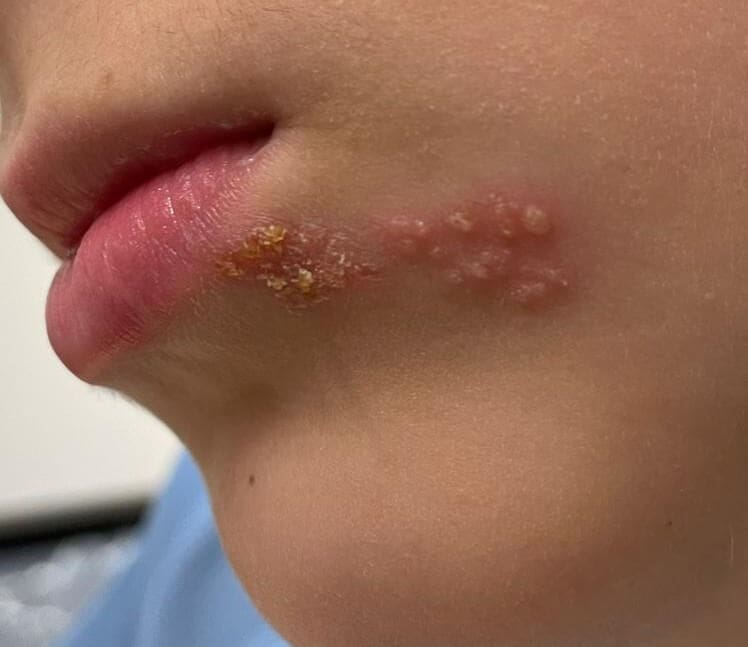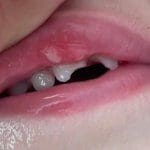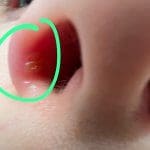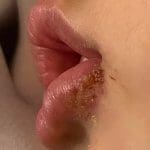
Herpes labialis (cold sore or fever blister)
On a personal level, I don’t love Herpes Simplex Virus Type I, and I will explain why later.
But generally speaking, on my website, you will be able to find a lot of important content about herpes that I know has reached and helped many children and families.
We have an important post that discusses the herpes virus. It focuses on the unpleasant infection that occurs when children meet the virus for the first time and suffer from painful lesions in the mouth and gingiva. Read more about this here.
We also have a post about the special way in which herpes skin infections present in children, Herpes Gladiatorum, link here.
But I recently realized that we do not have a post that discusses the most common herpes infection in children and adults – the cold sore or fever blister that usually develops around the lips.
This is the goal of this chapter.
If you remember when and how you got herpes for the first time and whether or not you had a severe infection, just know that the virus resides in your body and can re-appear as a small sore around your lips every once in a while. This chapter is for you.
Let’s starts with discussing the herpes virus family.
Who are the members of the herpes family and which one of them should we be familiar with for this chapter?
There are 8 different viruses within the herpes family. For example, did you know that herpes number 3 is the virus that causes chicken pox (read more here), that herpes number 4 is actually the famous EBV that causes infectious mononucleosis (more here), and that herpes 6 is the culprit behind roseola (more here)?
But those infections have their own posts on this website.
The two herpes viruses that cause skin infections in the area of the mouth and lips in children and adults are Herpes Simplex Type 1 (from here onwards I will refer to it as HSV-1),
and Herpes Simplex Type 2 (from here on I will refer to it as HSV-2).
HSV-1 is the main pathogen behind the lesions in the mouth and lips area.
What happens when children and adults contract HSV-1 for the first time?
Sometimes, nothing happens, and this is referred to as an asymptomatic infection. Other times an unpleasant infection can occur with severe involvement of the pharynx (or throat). This is referred to as a primary infection.
What happens following the primary infection in children (or adults)?
The herpes virus, just like the other members of this family, remains latent (dormant) somewhere in our nervous system and in some people, it tends to cause recurrent infections. The recurrent infection is also referred to as a non-primary infection. By now, the child or adult have already developed antibodies against the virus and so this will usually be a milder infection than the primary one.
What happens during a recurrent infection with HSV-1?
This is what happened to me during my wedding, probably as a result of the stress.
What usually happens is the development of a localized lesion, sometimes it can be big and other times smaller, and it is usually in the lip area. Take a look at the images below. (I didn’t post my wedding photos, don’t push it…)
What is this lesion called? Herpes labialis? Fever blister? Cold sore?
These are all very confusing terms.
The medical term that describes a recurrent infection in herpes in the mucosal area (mouth, lips, nose) is herpes labialis.
It can be referred to as a fever blister because fever is one of the triggers for a recurrent infection.
Where is the lesion most commonly located?
It is usually found on the lips, but as you can see in the images above, it can also be found in the nostrils and on the cheeks.
Herpes lesions that develop on distant areas of the skin are also referred to as Herpes Gladiatorum and you can read more about this skin infection here.
What precedes the development of the lesion?
Sometimes, there are no triggers prior to the development of the sore. Other times, there will be a clear trigger.
The different possible triggers include a febrile illness, severe cold, exposure to heat, an important exam or another significant event.
Can you tell when a herpetic lesion is about to develop?
So, I promised to share the story behind my long-term relationship with herpes with all of you. In fact, ever since I could remember myself (probably around the age of 4 years), I remember getting recurrent herpes labialis every few weeks.
As more and more time passed, I learned to recognize when I will be getting a sore, usually I can tell a few hours before its appearance.
I often feel a kind of tingling sensation around my lips. Many children and adults also get a similar sensation and know that they will wake up with a sore the next day. This preceding sensation is super important, because as you will see below, if you start taking the right medication immediately when the sensation starts, you can minimize the size of the sore substantially.
Of course, some people, and this has happened to me too, will just wake up in the morning to find a sore on their lips.
How can you tell whether or not the sore is herpetic?
Beyond the sensation that the person with the blister will have, the clinical appearance of the sore is also very characteristic. When the location of the sore differs, such as a sore in the nostrils, the sore is often mistaken with a bacterial infection and parents/doctors will sometimes suggest the use of anti-bacterial ointment rather than an anti-viral one.
Within a few days the blister dries up and you are left with a dry area of skin. A full resolution occurs within 6-10 days.
How can herpes be diagnosed?
In a hospital setting, PCR swabs taken from the lesion can be helpful. In practice, pediatricians and experienced parents know how to recognize a herpetic sore without the need for tests.
How can herpes be treated?
First of all it is important to determine when the best time for treatment is. The answer to this is – as soon as possible!
When a child approaches his/her parents and says he feels that he is going to develop a herpetic sore and they start him/her on medication, there is a good chance that they will minimize the size of the sore or even be able to prevent its development altogether.
The adequate treatment is anti-viral medication.
What type of medications do we have for herpes?
There are 3 available medications.
Acyclovir (Zovirax) as treatment for herpes labialis
Acyclovir is the oldest treatment used for herpes. Those who discovered it received a novel prize, and I personally owe them big time, as well.
Acyclovir is available as an intravenous formulation, tablets, suspension and cream. Zovirax is a common trade name for this medication. The advantage to acyclovir is its availability in many different formulations (including suspensions for children), and the main disadvantage is the fact that you need to take/apply it several times a day.
Valacyclovir (Valtrex) as treatment for herpes labialis
This is actually acyclovir with an additional supplement of valine, which improves the drug’s availability and makes it more readily absorbable. The advantage to valacyclovir is that it can be taken less times per day than acyclovir. The disadvantage is that it only comes in tablet form, so it is not a relevant option when it comes to kids.
Penciclovir as treatment for herpes labialis
This is another medication that is part of the acyclovir family. It is relatively new and has excellent bioavailability. It comes in the form of cream only and in most states it is not approved for children under the age of 12.
So, what should be done when children or adults have herpes labialis?
Early recognition and a generous application of one of the suitable creams (depending on the age of the patient), several times per day. I usually advise my patients to remove and reapply the cream every 3 hours during the first 24-48 hours of treatment.
Using suspension or tablets is not common practice for children with herpes labialis, but as an adult I tend to use the tablets in the first 24 hours quite often.
What are possible complications of cold sores/fever blisters in children?
Beyond the nasty sore, which is obviously very infectious in the first few days, there aren’t too many complications. Sometimes, because this sore is usually found on a “wet” area around the lips, it takes a while to dry up. Sometimes, a secondary bacterial infection can develop and this requires treatment with a local anti-bacterial cream.
When can the child go back to school/daycare?
As mentioned in the chapter where I discuss the return to daycare following infections, one can send their child back once the sore has fully dried.
To summurize, this is a super important topic both for children and adults. The most important point to send across, I would say, is to learn how to identify the development of the sore as early as possible and to start treatment as early as possible.
And don’t let the infection upset you… this herpes virus is so smart that it realizes when you are in distress and comes back to party.
It even partied at my own wedding!
For comments and questions, please register




